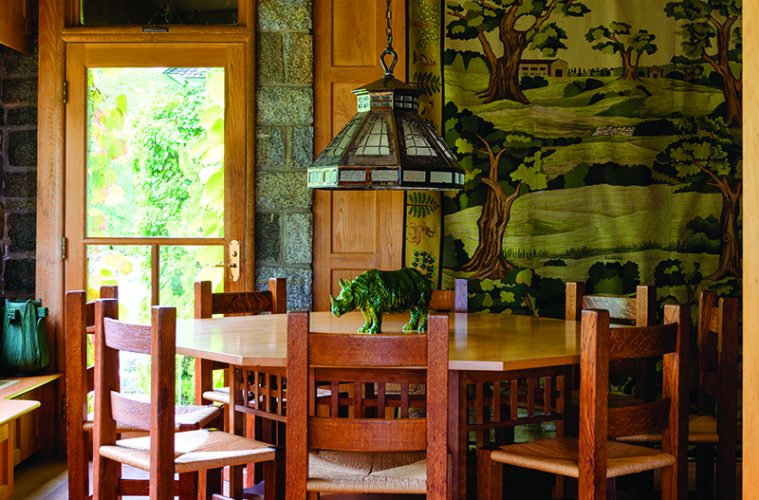There are furniture stores, and then there’s this exquisite Essex shop, where every last piece is quirky, unusual, and utterly compelling” is how one local magazine describes Andrew Spindler Antiques and Design in Essex.
The same can be said about Spindler’s 1937 Arts and Crafts home, which overlooks the water on a high bluff in East Gloucester. Not only is the house filled with an eclectic collection of beautiful objects from a range of eras and places, but the building itself is outfitted with resonant materials like wood from reclaimed church pews and earth-toned Moravian tile. “As an antiques dealer, I’m passionate about art and objects and design, so it’s sort of inescapable here,” Spindler says.
Spindler, who has lived here since 1990, now shares the almost 5,000-square-foot home with husband Hiram Butler, a contemporary art dealer who spends most of his time in Houston, Texas. Butler’s influence can be felt throughout the five-bedroom, four-and-a-half-bathroom house, such as in the guest bedroom’s huge Richard Serra print that reflects the room’s horizon-line theme with a stark horizontal created by planes of black and white.
The house is becoming a reflection of our two worlds, our tastes, and our visions,” says Spindler. “We absolutely have influenced one another’s ways of seeing.”
Spindler’s way of seeing is born of his pedigree as a curator of fine historical objects, the training for which he pursued at Brown and Yale universities and Sotheby’s Institute. The heavy influence of Arts and Crafts in the house belies his devotion to the classical—evidenced in almost every room.
A large painting of a neoclassical scene of Pegasus over a classic landscape by Rockport painter Vesper George is affixed to the ceiling of the two-story entry vestibule. An orange 1820s French daybed is a centerpiece of the yellow library upstairs, which Spindler describes as “filled with neoclassical things.” A bright-green gilded neoclassical bookcase presides over one of the guest rooms.
I happen to love classical things,” Spindler says. “It’s never gotten old. Good proportions and clean lines.”
But as the pairing of a 1968 Danish harp chair and a English chaise (circa 1810) in the master bedroom suggests, the house’s décor is nothing if not multifaceted. Bumping up against the classical furnishings is a charming, prismatic mix of styles.
For example, the daybed in the library shares space with a 1920s club chair upholstered in a bold plaid fabric by hip New York designer Lulu DK. Prairie School stained glass windows grace the dining room, while the master bathroom features salvaged stained glass from Switzerland (circa 1890). An Anglo-Indian chaise upholstered in “guerande” velvet from Manuel Canovas rubs elbows with a Frank Lloyd Wright table in the living room.
As the Wright table suggests, the Arts and Crafts influence is stronger on the first floor, particularly in the living room, where a Charles Linbert table shares space with Gustav Stickley chairs—including one from the estate of photographer Robert Mapplethorpe. A horizontal mural (circa 1920) by Gloucester painter Jonas Lie, founder of the Norwegian Arts and Crafts Club, tops the room’s walls. The painting, which used to grace a lodge in the Adirondacks, depicts the voyage of the Vikings from Scandinavia to North America.
From the outside, the house is also predominantly influenced by Arts and Crafts, with double-hung and casement windows with four-pane top sashes in celadon-green, square columns on square stone bases in the portico, and sidelights on the front door. The lower story is made of local thick-cut granite, reflecting the Arts and Crafts movement’s reverence for indigenous materials, and the upper portion is covered with overlapping fish-scale shingles imported from Switzerland.
It has a warm, Hansel-and-Gretel-y vibe to it,” muses Spindler.
The 1.5-acre garden that surrounds the house is also a stunning example of Arts and Crafts design, which, according to Harvard garden historian Judith B. Tankard, “bequeathed a rich legacy of gardens.” Arts and Crafts gardens focus on making use of the natural qualities of a site, incorporating local materials, and linking the outdoors to a building’s interior. The garden is a magical maze of paths and secret spaces created by the undulating landscape of glacier-deposited boulders on which the house was built.
During the Arts and Crafts period, Tankard notes, “gardens took on a new meaning as an essential component of the house, rather than as a separate entity.” Spindler made changes to the house to enhance the indoor-outdoor connection: Installing French doors in the living room, enlarging the window in the kitchen that overlooks the Japanese-inspired garden of Spindler’s design, raising the back terrace with granite blocks to make its floor even with the house’s.
I love the stone terrace and just being able to connect to it and be aware of it,” says Spindler. In the summer, he throws open the living room’s French doors and installs screens in the adjacent enclosed porch. “You don’t even have to be outside to be in the garden.”
Even upstairs, the outdoors is ever-present. From the windows and the balcony that extends the length of the house, vistas of sea and sky sweep the eye across the garden and out to the horizon.
The interiors are wonderful, but when you walk into these rooms, it’s like a moth going to a window where there’s light,” says Spindler.
And the solid, naturalistic sensibility of the house itself reflects the textured, craggy space outside those windows. Inside and outside, the materials of this home’s construction are drawn straight from nature without embellishment: rough-hewn stone, handmade clay tile, unadorned wood. It’s a house that feels organically connected to its surroundings, as dramatic and simultaneously quotidian as the boulders it graces.
I love the grandeur of [the house], but it’s not pretentious,” says Spindler. “It has a power, but it’s really natural and really honest.”
Article appears in the Fall 2015 issue of Northshore Home magazine.

